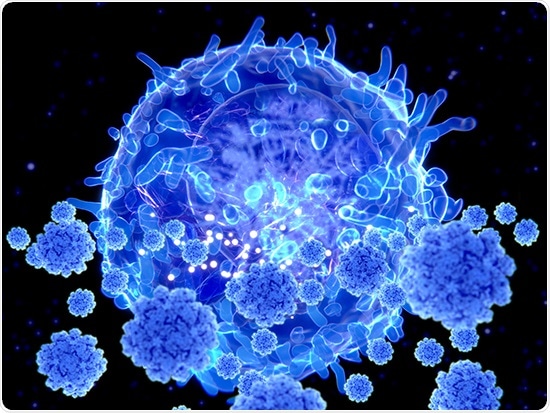CD8+ T cells, also called “killer” T cells, are the killers of the immune system. Upon being primed, they look for and kill cancerous cells or virus-infected cells.

This finding upends the long-held paradigm that priming during lung infections takes place only in the draining lymph nodes, and it will be key to developing more efficient vaccinations and therapies for respiratory challenges. Image Credit: University of Alabama at Birmingham.
The process of priming involves dendritic cells, which are the sentinels of the immune system. For instance, during influenza infection in the lungs, lung-migratory dendritic cells trap a piece of the viral antigen, migrating out of the lung to the area where naïve T cells can be found to present the antigen to the CD8+ T cells. Thus, the T cells are primed to know which cells to attack.
For a long time, it was considered that the place for the priming in influenza was restricted to a single anatomical site—the lung-draining, mediastinal lymph nodes situated between the lungs and the spine. A new study published in the Science Immunology journal now challenges this lymph node-centric paradigm.
Led by André Ballesteros-Tato, Ph.D., associate professor in the University of Alabama at Birmingham Department of Medicine Division of Clinical Immunology and Rheumatology, scientists have identified an unobserved additional site for CD8+ T cells priming—the spleen.
This is astonishing and crucial. It is astonishing because there is a lack of lymph vasculature connection between the lungs and the spleen. It is crucial, notes Ballesteros-Tato because CD8+ T cells primed in the spleen are transcriptionally unique and are destined for an alternative fate than the T cells in the lymph nodes.
CD8+ T cells primed in the lymph nodes are delegated to turn into T effector cells that return to the lungs to combat infection. However, those that get primed in the spleen produce precursors with an improved ability to differentiate into long-lived, stem-like memory T cells. Such memory cells can quickly respond to future infection by the flu virus, thereby offering long-lasting protective immunity.
We demonstrate that CD8+ T cells, responding to the same antigen in different anatomical locations, gives rise to cells with distinct functional capabilities. thereby providing a new ‘anatomical model’ for how T cell diversity is generated after infection.”
André Ballesteros-Tato, Associate Professor, Department of Medicine Division of Clinical Immunology and Rheumatology, University of Alabama at Birmingham
“Our results demonstrate a dendritic cell-trafficking pathway that connects the lung with the blood circulation and identify the spleen as a primary site for the priming of long-lived memory T cell precursors. These data will be critical for the development of more efficient vaccination and therapeutic strategies to respiratory challenges,” added Ballesteros-Tato.
With a mouse/influenza virus infection model, the UAB researchers identified that priming in the spleen was performed by a fraction of the migratory lung dendritic cells that leave the lymph node, enter the bloodstream, and reach the spleen.
Apart from transcriptional differences for primed T cells in the spleen, fate-mapping experiments demonstrated that spleen-primed CD8+ T cells were long-lasting and added considerably to the pool of long-lasting memory cells when compared to CD8+ T cells primed in the mediastinal lymph nodes.
Ballesteros-Tato and his team then demonstrated that 45 days following infection, the spleen-primed CD8+ T cells and lymph node-primed CD8+ T cells were phenotypically indistinguishable, and thus the spleen-primed T cells had a very high capacity to respond to a rechallenge infection of influenza virus and expand into a population of infection-fighting T effector cells.
From experimental results that support the new paradigm, the team identified that when dendritic cells could not migrate out of the lung, or when the exit of lymph node was blocked, dendritic cells with lung-derived antigens did not accumulate in the spleen, thus preventing splenic T cell priming.
However, the question remains how the lung migratory dendritic cells reach the spleen from the lymph nodes.
Neither the mediastinal lymph nodes nor the lungs are directly connected to the spleen by the lymphatic vasculature. Thus, the only possible route for migratory dendritic cells to access the spleen from the mediastinal lymph nodes is via the thoracic duct, which channels the efferent lymph back into the blood circulation.”
André Ballesteros-Tato, Associate Professor, Department of Medicine Division of Clinical Immunology and Rheumatology, University of Alabama at Birmingham
Ballesteros-Tato observed that a major understanding of stem-like CD8+ T cells has been achieved from studies in tumor models or chronic systemic viral infections. “To this day,” he added, “no studies have been performed to address the question of how these cells are generated in the context of respiratory viral infections.”
Source:
Journal reference:
Jenkins, M. M., et al. (2021) Lung dendritic cells migrate to the spleen to prime long-lived TCF1hi memory CD8+ T cell precursors after influenza infection. Science Immunology. doi.org/10.1126/sciimmunol.abg6895.